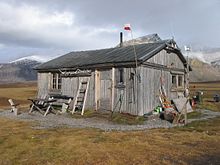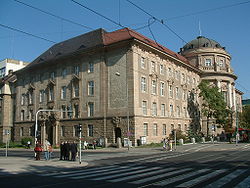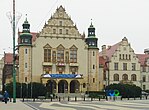Adam Mickiewicz University in Poznań
Uniwersytet im. Adama Mickiewicza w Poznaniu | |
Latin: Universitas Studiorum Mickiewicziana Posnaniensis | |
Former names | Piast University (1919–1920) University of the Western Lands (1940–1945) University of Poznań (1920–1955) |
|---|---|
| Type | Public university |
| Established | 7 May 1919[1] |
| Rector | Bogumiła Kaniewska |
Academic staff | ~2,996 faculty members (Fall 2018) |
Administrative staff | ~2,181 (Fall 2018)[2] |
| Students | ~38,000 (Fall 2018)[3] |
| ~1,300 (Fall 2018) | |
| Location | , , |
| Campus | Urban |
| Affiliations | EUA, EUCEN, CGU, SGroup |
| Website | international |
 | |
The Adam Mickiewicz University[4] (Polish: Uniwersytet im. Adama Mickiewicza w Poznaniu; Latin: Universitas Studiorum Mickiewicziana Posnaniensis) is a research university in Poznań, Poland.
It traces its origins to 1611, when under the
The university is organized into six principal academic units—five research schools consisting of twenty faculties and the doctoral school—with campuses throughout the historic Old Town and Morasko. The university employs roughly 4,000 academics, and has more than 40,000 students who study in some 80 disciplines. More than half of the student body are women. The language of instruction is usually Polish, although several degrees are offered in either German or English. The university library is one of Poland's largest, and houses one of Europe's largest Masonic collections, including the 1723 edition of James Anderson's The Constitutions of the Free-Masons.[9][10][11]
The university is currently publishing over 79 research journals, most of them on Pressto[12] publishing platform based on Open Journal System. Adam Mickiewicz University Repository (AMUR)[13] contains over 23,704 records of research publications[14] and is one of the first research repositories in Poland.
Due to its history, the university is traditionally considered among Poland's most reputable institutions of higher learning, this standing equally being reflected in national rankings. Adam Mickiewicz University is a member of the European University Association, EUCEN, SGroup European Universities' Network, Compostela Group of Universities and EPICUR.[15]
History

From the beginning, the history of the Adam Mickiewicz University has been inextricably linked to the history of
After the
Sites

The university's central administrative building is Collegium Minus, on the west side of Adam Mickiewicz Square at the western end of the street

The university also uses a number of other buildings in southern and western districts of Poznań. However, it is strongly developing its site at Morasko in the north of the city. As of 2006, the faculties of physics, mathematics and computer science, biology, geographical and geological science had moved to the new location. In 2015 they were joined by the faculty of history (Collegium Historicum Novum).[17]
The university also has external branches in other towns of western Poland, including
University owns a seasonal polar research station located in the Petuniabukta (Petunia Bay), in the Northern part of Billefjord, and central part of Spitsbergen island in the Svalbard archipelago.[18]
Staff and student numbers

At the start of the 2008/2009 academic year, the university had 46,817 undergraduates (including about 18,000 on weekend or evening courses), 1308 doctoral students, and 2247 other post-graduate students. The number of undergraduates declined slightly between 2005 and 2008.[19]
At the end of 2008, the university had a total of 2892 teaching staff, including 257 full professors and 490 associate/assistant professors. It also had 2120 other employees.[20]
Reputation
| University rankings | |
|---|---|
| Global – Overall | |
| ARWU World[21] | 701–800 (2019) |
| Global – Liberal arts | |
| QS Arts & Humanities[22] | 371 (2020) |
| Regional – Overall | |
| QS Emerging Europe and Central Asia[23] | 52 (2022) |
The Adam Mickiewicz University is one of the top
On the list of the best Emerging Europe and Central Asia universities compiled by QS University Rankings, the Adam Mickiewicz University was placed as 60th. In 2020, QS World University Ranking by Subject positioned the Adam Mickiewicz University as one of the best higher level institutions among the top 101–150 in Linguistics, 251–300 in English studies, 371 in Arts & Humanities and 551–600 in Physics & Astronomy, Chemistry and Biology.[22]
Degrees

Like most Polish universities, Adam Mickiewicz University awards the following degrees:
- licencjat, normally a three-year course, sometimes considered equivalent to a Bachelor of Arts or Bachelor of Sciencedegree
- magister, normally a two-year course following the licencjat, considered equivalent to a Master of Arts or Master of Sciencedegree
- doctorates
- habilitations
Schools and faculties


- School of Natural Sciences[4]
- Faculty of Biology
- Faculty of Geographic and Geological Sciences
- School of Exact Sciences
- School of Social Sciences
- Faculty of Human Geography and Planning
- Faculty of Political Science and Journalism
- Faculty of Law and Administration
- Faculty of Psychology and Cognitive Science
- Faculty of Sociology
- Faculty of Educational Studies
- School of Humanities
- Faculty of Anthropology and Cultural Studies
- Faculty of Archeology
- Faculty of Philosophy
- Faculty of History
- Faculty of Arts Studies
- Faculty of Theology
- School of Languages and Literatures
- Doctoral School of Adam Mickiewicz University
People
Notable alumni and staff


Adam Mickiewicz University's prestige and large class size have enabled it to graduate a large number of distinguished alumni.
Many AMU alumni are leaders and innovators in the business world, as well as prominents in society and the arts. Its graduates include authors (
Notable academic staff included:
- archeologists: Józef Kostrzewski;
- historians: Stanisław Kozierowski, Gerard Labuda, Henryk Łowmiański, Anna Wolff-Powęska;
- legal scholars: Zygmunt Ziembiński, Czesław Znamierowski, Antoni Peretiatkowicz, Michał Sczaniecki, Sławomira Wronkowska-Jaśkiewicz, Witalis Ludwiczak;
- philosophers: Kazimierz Ajdukiewicz, Władysław Tatarkiewicz, Leszek Nowak;
- linguists: Wiktor Jassem, Grażyna Vetulani;
- literature scholars: Zygmunt Szweykowski, Edward Balcerzan, Stanisław Barańczak;
- sociologists: Florian Znaniecki.
Three graduates of the university have served as Marshals of the Sejm and Senate of the Republic of Poland. Józef Zych, Deputy Marshal of the Sejm (1991–1995, 2001–2005), Marshal of the Sejm (1995–1997), Senior Marshal (2005, 2011); Marek Jurek, Marshal of the Sejm (2005–2007); Rafał Grupiński, Deputy Marshal of the Senate (from 2023).
Three of the school's graduates, including
Among the university's notable graduates are also:
- Bogumił Brzezinski (b. 1943), chemist
- Krzysztof Czyżewski (b. 1958), author
- Elżbieta Frąckowiak (b. 1950), electrochemical engineer
- General Staff of the Polish Armed Forces
- Krzysztof Grabowski (b. 1965), poet and singer
- anatomistand communist-era dissident
- Anna Jantar (1950–1980), singer
- Tomasz Jasiński (b. 1951), historian
- Włodzimierz Kołos (1928–1996), chemist and physicist, one of the founders of modern quantum chemistry
- Dominika Kulczyk (b. 1977), sinologist, businesswoman and philanthropist
- Tomasz Łuczak (b. 1963), mathematician
- artist
- Halszka Osmólska (1930–2008), paleontologist
- Karolina Pawliczak (b. 1976), lawyer and politician
- Jan Sokołowski(1899–1982), zoologist
- Adam Szłapka (b. 1984), politician, leader of the Modern political party
- Wanda Wesołowska (b. 1950), zoologist
- Jan Węglarz (b. 1947), computer scientist
The Enigma Codebreakers
In the 1920s the German military began using a 3-rotor Enigma, whose security was increased in 1930 by the addition of a plugboard. The
After the class, the Bureau recruited some students to work part-time at a Bureau branch set up in Poznań for the students. The branch operated for some time. On 1 September 1932, 27-year-old Polish mathematician Marian Rejewski and two fellow Poznań University mathematics graduates, Henryk Zygalski and Jerzy Różycki, joined the Bureau full-time and moved to Warsaw. Their first task was to reconstruct a four-letter German naval cipher.[31][32]
Honorary doctors
Recipients of honorary doctorates from the university include Marshal
List of rectors
- 1919–1923: Heliodor Święcicki (1854–1923), doctor and philanthropist
- 1923–1924: Zygmunt Lisowski (1880–1955), lawyer
- 1924–1925: Stanisław Dobrzycki (1875–1931), Slavic language specialist
- 1925–1926: Ludwik Sitowski (1880–1947), zoologist
- 1926–1928: Jan Gabriel Grochmalicki (1883–1936), zoologist
- 1928–1929: Edward Lubicz-Niezabitowski(1875–1946), doctor and zoologist
- 1929–1931: Stanisław Kasznica (1874–1958), lawyer
- 1931–1932: Jan Sajdak (1882–1967), classical philologist
- 1932–1933: Stanisław Pawłowski (1882–1940), geographer
- 1933–1936: Stanisław Runge (1888–1953), veterinarian
- 1936–1939: Antoni Peretiatkowicz (1884–1956), lawyer
- 1939: Bronisław Niklewski (1879–1961), plant physiologist
- 1945–1946: Stefan Tytus Dąbrowski (1877–1947), doctor and physiologist
- 1946–1948: Stefan Błachowski (1889–1962), psychologist
- 1948–1952: Kazimierz Ajdukiewicz (1890–1963), philosopher and logician
- 1952–1956: Jerzy Suszko (1889–1972), chemist
- 1956–1962: Alfons Klafkowski (1912–1992), lawyer
- 1962–1965: Gerard Labuda (1916–2010), historian
- 1965–1972: Czesław Łuczak (1922–2002), historian
- 1972–1981: Benon Miśkiewicz (1930–2008), historian
- 1981–1982: Janusz Ziółkowski (1924–2000), economist and sociologist
- 1982–1984: Zbigniew Radwański (1924–2012), lawyer
- 1984–1985: Franciszek Kaczmarek (1928–2015), physicist and mathematician
- 1985–1988: Jacek Fisiak (1936–2019), English philologist
- 1988–1990: Bogdan Marciniec (born 1941), chemist
- 1990–1996: Jerzy Fedorowski (born 1934), geologist
- 1996–2002: Stefan Jurga (1946–2022), physicist
- 2002–2008: Stanisław Lorenc (1943–2020), geologist
- 2008–2016: Bronisław Marciniak (born 1950), chemist
- 2016–2020: Andrzej Lesicki (born 1950), biologist
- 2020– : Bogumiła Kaniewska (born 1964), Polish philologist
Gallery
-
Faculty of Geographical and Geological Sciences
-
Faculty of Mathematics and Computer Science
-
Faculty of Biology
-
Collegium Polonicum in Słubice
International cooperation
- Christian-Albrechts-Universität zu Kiel, Germany
- Otto-Friedrich-Universität Bamberg, Germany
- University of Greifswald, Germany
- Universität Wien, Austria
- Masaryk University, Brno, Czech Republic
- Université Libre de Bruxelles, Belgium
- University of Rennes 2 – Upper Brittany, France
- Universidad Complutense de Madrid, Spain
- Indiana University of Pennsylvania, Pennsylvania, US
- Cornell University Ithaca, New York, US
- Università degli Studi di Udine, Italy
- Università degli Studi di Urbino, Italy
- Sabancı University, Istanbul, Turkey
- Universidade de Aveiro, Portugal
- University of Agder, Norway
- Doğuş University, Istanbul, Turkey
- Anadolu University, Eskişehir, Turkey
- Balıkesir University, Balıkesir, Turkey
- Çukurova University, Adana, Turkey
See also
References
- ^ UAM, Administrator strony. "UAM świętuje 101. urodziny – Uniwersytet im. Adama Mickiewicza w Poznaniu". amu.edu.pl.
- ^ "Stan zatrudnienia i liczba studiujących w Uniwersytecie im. Adama Mickiewicza w Poznaniu" (in Polish). Biuletyn Informacji Publicznej. Archived from the original on 12 May 2018. Retrieved 19 January 2018.
- ^ "Adam Mickiewicz University, Poznań – Adam Mickiewicz University". European Legal Studies – Adam Mickiewicz University. 5 September 2016. Archived from the original on 28 May 2022. Retrieved 18 March 2021.
- ^ a b "Adam Mickiewicz University English Glossary". Adam Mickiewicz University.
- ^ a b "History". Archived from the original on 1 December 2017. Retrieved 26 November 2017.
- ^ "History – The Poznań Society for the Advancement of Arts and Sciences". Retrieved 6 June 2020.
- ^ a b "Adam Mickiewicz University, Poznań". European Legal Studies – Adam Mickiewicz University. Archived from the original on 28 May 2022. Retrieved 6 June 2020.
- ^ a b [1] The history of AMU. Uniwersystet Adama Mickiewicza
- ^ "Europe's largest collection of Masonic prints in Polish city of Poznań". www.thefirstnews.com. Retrieved 6 June 2020.
- ^ Grażyńska, Iuliana (2015). "Colecţia masonică a Bibliotecii Universitare din Poznań".
- ^ "Major events in the history of the Library". UNIVERSITY LIBRARY. Retrieved 25 January 2020.
- ^ "Pressto Open Publishing Platform". www.pressto.amu.edu.pl (in Polish and English). Retrieved 9 October 2020.
- ^ "Adam Mickiewicz University Repository". AMUR Repository (in Polish and English). Retrieved 9 October 2020.
- ^ "AMUR OAI-PMH interface". Retrieved 9 October 2020.[permanent dead link]
- ^ "Partnership".
- ^ Wardełski, Adam (2011). "Prof. Stanisław Pawłowski (film)". Filmoteka UAM (in Polish). Retrieved 29 December 2014.
- ^ "Wydział Historyczny – O Wydziale". wydzial.historyczny.amu.edu.pl. Archived from the original on 25 October 2019. Retrieved 10 July 2016.
- ^ "Home". polar.amu.edu.pl. Retrieved 6 June 2020.
- ^ Rector's Report 2008, p. 25 ff.
- ^ Rector's Report 2008, p. 51 ff. and Appendix 10
- ^ Academic Ranking of World Universities 2019
- ^ a b "Adam Mickiewicz University, Poznań". Top Universities. 16 July 2015. Retrieved 6 June 2020.
- ^ "QS World University Rankings-Emerging Europe & Central Asia". Retrieved 15 January 2023.
- ^ University Ranking at Perspektywy.pl [2] (in Polish)
- ^ "Academic Ranking of World Universities 2018". Archived from the original on 7 December 2018. Retrieved 7 December 2018.
- ^ "Jan Nowak-Jeziorański (1914–2005)". Retrieved 16 April 2020.
- ISBN 978-1-44731-578-0
- ^ Winiarski received his Habilitation at the Faculty.
- ^ "The Enigma Codebreakers – POZnan.travel". poznan.travel. Retrieved 6 June 2020.
- ^ "Effort to crack Enigma remembered". BBC News. 14 July 2011. Retrieved 6 June 2020.
- ISSN 0307-1235. Retrieved 6 June 2020.
- PMID 30214032.
- ^ "Prof. Krzysztof Matyjaszewski doktorem honoris causa UAM" (in Polish). naukawpolsce.pap.pl. Retrieved 11 June 2022.
- ^ Redakcja (12 May 2011). "Daimler brytyjskiego miliardera Roberta Maxwella w rękach poznaniaka [ZDJĘCIA, WIDEO]". Poznań Nasze Miasto (in Polish). Retrieved 26 February 2023.
- ^ "Wstydliwy doktor". Przegląd (in Polish). 3 June 2019. Retrieved 26 February 2023.
- ^ "Robert Maxwell - "pierwszy biograf Jaruzelskiego"". salon24.pl (in Polish). 8 June 2019. Retrieved 26 February 2023.
- ^ UAM, Administrator strony (29 June 2023). "Orhan Pamuk doktorem honoris causa UAM - Uniwersytet im. Adama Mickiewicza w Poznaniu". amu.edu.pl (in Polish). Retrieved 4 July 2023.
- ^ "Wisława Szymborska skończyłaby dziś 96 lat | Kraków w Pigułce" (in Polish). 2 July 2019. Retrieved 6 June 2020.
- ^ "The Nobel Prize in Literature 1996". NobelPrize.org. Retrieved 6 June 2020.
External links
- Official website (in English)
- Official website (in Polish)










